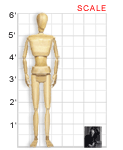From the collection of:
Clara M. Eagle Gallery, Murray State University || VAM Home
Imogen Cunningham (American, 1883-1976)
ALFRED STIEGLITZ, 1934
Photograph; 7-1/2" X 9-1/2"
1979.4.3
Clara M. Eagle Gallery, Murray State University
The subject of this portrait by Imogen Cunningham, Alfred Stieglitz (1864-1946), is one of the most notable figures in the history of photography. As a member of a movement known as Pictorialism, Stieglitz promoted photography as an art instead of a science, contending that the camera was but a tool, much like a paintbrush. Pictorialists tried to show that they were a part of the art tradition by manipulating their photos in the darkroom, using tricks and techniques that were evidence of the human hand in the process.
Cunningham boldly introduced herself to the often intimidating Stieglitz while she was in New York City in 1910. Impressed by her photography, he went on to have a significant influence on Cunningham’s work and career. Stieglitz was the first to urge her to open her own studio, which she did with success.
About the Artist
Imogen Cunningham was born in Portland, Oregon, in April 1883. Her experience with photography began in 1901, when she enrolled in a photography course by correspondence. After graduating from the University of Washington in Seattle with a degree in chemistry, she went to work for photographer Edward C. Curtis. It was in his studio that Cunningham learned the art of platinum printing.
In 1909, Cunningham went to Dresden, Germany, to study photographic chemistry. Upon her return to the U.S. in 1910, she opened her own portrait studio. She soon gained national recognition as a photographer. Later, she became part of a group of enthusiastic photographers founded by Ansel Adams and Willard Van Dyke in 1934 under the name of Group f/64. (The name was chosen because the lens aperture setting of f/64 provides the ultimate in resolution and depth of field.)
Cunningham took photographs for magazines, operated her portrait studio, and eventually taught at the San Francisco Art Institute. She photographed numerous influential and famous people, including film stars and politicians. She began her last project, entitled After Ninety, at the age of 92. This final collection of portraits was never completed, as the project was interrupted by her death in 1976.
Classroom Ideas
Discussion: Does this photograph convey a certain mood? How or why? What, if anything, distinguishes a fine art photograph from just an ordinary picture?
Born within a year of each other, Imogen Cunningham and Doris Ulmann (see Aunt Sophie Campbell, Pipes in the Berea College gallery) were both important photographers of the 20th century. Compare and contrast the work of the two. What qualities present in their work help explain why both women were able to succeed in a competitive field dominated by men?
Activity: Look through magazines and newspapers for photographs that capture your interest. Create a classroom display and discuss what attributes make photography artistic. Try your hand at photography, taking pictures of your friends, school, or community. Choose your best prints for a display.
Links
You’ll find extensive information about Cunningham at the Imogen Cunningham Trust web site.
[www.imogencunningham.com]
View other images of Cunningham’s work at these sites:
- George Eastman House
[www.geh.org/fm/cunningham/htmlsrc/cunningham_sld00001.html] - Hofstra Museum
[www.hofstra.edu/COM/Museum/museum_collection_76_05.cfm] - Pomona College Museum of Art
[web-kiosk.pomona.edu/THA323*1$26*453]
For information about the life and work of Alfred Stieglitz, visit the Minneapolis Museum of Art’s Get the Picture photography web site.
[www.artsmia.org/get-the-picture/stieglitz/]

